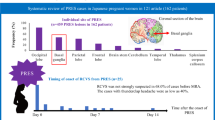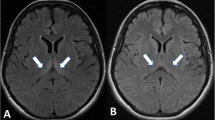Abstract
Posterior reversible encephalopathy syndrome is a proposed cliniconeuroradiological entity characterized by headache, altered mental status, cortical blindness, seizures, and other focal neurological signs, and a diagnostic magnetic resonance imaging picture. A variety of different etiologies have been reported like hypertension, pre-eclampsia/eclampsia, cyclosporin A or tacrolimus neurotoxicity, uraemia and porphyria. With early diagnosis and prompt treatment, the syndrome is usually fully reversible. We report a case of recurrent PRES of unknown aetiology following intensive care unit treatment and only moderately elevated blood pressure. Clinicians as well as radiologists must be familiar with this clinically frightening, underdiagnosed condition to assure timely diagnosis and treatment to prevent persistent deficits.
This is a preview of subscription content, access via your institution
Access options
Subscribe to this journal
Receive 12 digital issues and online access to articles
$119.00 per year
only $9.92 per issue
Buy this article
- Purchase on Springer Link
- Instant access to full article PDF
Prices may be subject to local taxes which are calculated during checkout


Similar content being viewed by others
References
Casey SO et al. Posterior reversible encephalopathy syndrome: utility of fluid-attenuated inversion recovery MR imaging in the detection of cortical and subcortical lesions. Am J Neuroradiol 2000; 21: 1199–1206.
Hinchey J et al. A reversible posterior leukoencephalopathy syndrome. N Engl J Med 1996; 334: 494–500.
Schwartz RB et al. Diffusion-weighted MR imaging in hypertensive encephalopathy: clues to pathogenesis. Am J Neuroradiol 1998; 19: 859–862.
Schwartz RB et al. Preeclampsia–eclampsia: clinical and neuroradiographic correlates and insights into the pathogenesis of hypertensive encephalopathy. Radiology 2000; 217: 371–376.
Truwit CL et al. MR imaging of reversible cyclosporin A-induced neurotoxicity. Am J Neuroradiol 1991; 12: 651–659.
Utz N et al. MR imaging of acute intermittent porphyria mimicking reversible posterior leukoencephalopathy syndrome. Neuroradiology 2001; 43: 1059–1062.
Ay H et al. Posterior leukoencephalopathy without severe hypertension: utility of diffusion-weighted MRI. Neurology 1998; 51: 1369–1376.
Edvinsson L, Owman C, Sjoberg NO . Autonomic nerves, mast cells, and amine receptors in human brain vessels. A histochemical and pharmacological study. Brain Res 1976; 115: 377–393.
Casey SO, Truwit CL . Pontine reversible edema: a newly recognized imaging variant of hypertensive encephalopathy? Am J Neuroradiol 2000; 21: 243–245.
Chang GY, Keane JR . Hypertensive brainstem encephalopathy: three cases presenting with severe brainstem edema. Neurology 1999; 53: 652–654.
Morello F et al. Hypertensive brain stem encephalopathy: clinically silent massive edema of the pons. Neurol Sci 2001; 22: 317–320.
Author information
Authors and Affiliations
Corresponding author
Rights and permissions
About this article
Cite this article
Hagemann, G., Ugur, T., Witte, O. et al. Recurrent posterior reversible encephalopathy syndrome (PRES). J Hum Hypertens 18, 287–289 (2004). https://doi.org/10.1038/sj.jhh.1001664
Received:
Revised:
Accepted:
Published:
Issue Date:
DOI: https://doi.org/10.1038/sj.jhh.1001664
Keywords
This article is cited by
-
Neurological Manifestations of Acute Porphyrias
Current Neurology and Neuroscience Reports (2022)
-
Characteristics and Outcomes of Critically Ill Pediatric Patients with Posterior Reversible Encephalopathy Syndrome
Neurocritical Care (2020)
-
Anti-Angiogenic Tyrosine Kinase Inhibitors and Reversible Posterior Leukoencephalopathy Syndrome: Could Hypomagnesaemia Be the Trigger?
Drug Safety (2017)
-
Posterior reversible encephalopathy syndrome after depletive lumbar puncture: a case report
Journal of Medical Case Reports (2014)
-
Posteriores reversibles Enzephalopathiesyndrom (PRES)
Intensivmedizin und Notfallmedizin (2010)



